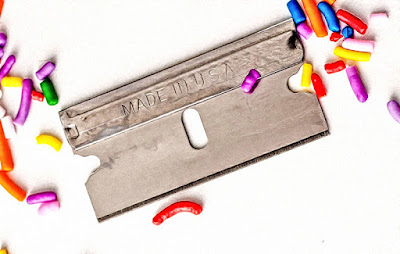Self-cutting in adolescents is the strongest predictor for subsequent suicide attempts. It is a clear signal of severe psychological pain being released physically by the act of self-cutting. However, relief is only temporary, and if ignored self-cutting can progress to suicide.


Self-cutting and Suicide
Repeated self-cutting in adolescents is the strongest predictor of attempted suicide. 70% of those who self-cut will attempt suicide at least once. The number of suicide attempts increases with the number of years engaged in self-cutting (Nock 2006). The risk of attempted suicide is higher than with any other psychiatric disorder including depression and borderline personality disorder. Self-cutting may be a uniquely important risk factor for suicide because its presence is associated with both increased desire and capability for suicide (Klonsky 2013).
Ms LM, 15 years old, was brought by her parents for counselling after a suicide attempt. She subsequently revealed repeated self-cutting over the upper, inner thighs after sexual abuse two years previously.
Self-cutting and Psychological Pain
The majority of people who self-cut do so to relieve intense psychological pain. It occurs independently of a diagnosis of borderline personality disorder, or history of sexual abuse in childhood (Klonsky 2014). Self-cutting has a calming effect. (Klonsky 2006). This is much the same way as applying a balm, the superficial irritation suppresses the underlying deep pain. Individuals who self-cut continue to do so because it decreases feelings of anxiety (Haines 1995). Some people self-cut to punish themselves. A small minority self-cut for attention seeking or to escape from responsibilities.
Ms RX, 24 years old: 'When I cut myself I feel calm, I don't feel the pain'.
Self-cutting Scars
The scars of self-cutting can trigger distressing memories of a time of psychological pain. Seeing self-cutting scars on friends or hearing of self-cutting incidents can induce the urge to self-cut.
Ms KJ, 19 years old, had a history of self-cutting since middle school and was now coping well in a professional course while staying in hostel. She accidently saw self-cutting scars on her room mate. Since then she is anxious and fighting urges to self-cut.
An increasing number of self-cutting scars is associated with presence of suicide ideation and a history of suicide attempts (Taylor 2016). Visible scars on exposed parts of the body can restrict career and social choices. Skin grafting may be required in some cases (Todd 2012)
Mr JS, 21 years old, underwent training and qualified for an initial pilots license. During medical evaluation for a commercial pilots license self-cutting scars were noted on his chest. He was medically disqualified as a hazard to flight safety.
Why do some people self-cut and not others?
Biology may have an answer. A particular gene for serotonin regulation (5-HTTLPR) may be defective. Youths who face severe chronic interpersonal stress and have the defectives gene self-cut more than those with the fully functioning gene (Hankin 2014). Those who self-cut have reduced autonomic and stress responses to anticipation of pain making them less likely to avoid it. They also have increased responses after pain which reduces feelings of numbness and distress, and increases body awareness. This combination serves to reinforce self-cutting behaviour (Koenig 2017).
Self-cutting is a unique physical marker of severe psychiatric problems. Approach a mental-health professional for treatment.
References
- Rebecca C. Brown and Paul L. Plener. Non-suicidal Self-Injury in Adolescence. Curr Psychiatry Rep. 2017; 19(3): 20. Published online 2017 Mar 17. doi: 10.1007/s11920-017-0767-9. Accessed 2018-09-14.
- Haines J, Williams CL, Brain KL, Wilson GV. The psychophysiology of self-mutilation. J Abnorm Psychol. 1995 Aug;104(3):471-89.
- Benjamin L. Hankin, Andrea L. Barrocas, Jami F. Young, Brett Haberstick, and Andrew Smolen. 5-HTTLPR x interpersonal stress interaction and nonsuicidal self-injury in general community sample of youth. Psychiatry Res. 2015 Feb 28; 225(3): 609–612. Published online 2014 Dec 3. doi: 10.1016/j.psychres.2014.11.037. Accessed 2018-09-13
- Klonsky ED. The functions of deliberate self-injury: a review of the evidence. Clin Psychol Rev. 2007 Mar;27(2):226-39. Epub 2006 Oct 2. Accessed 2018-09-12.
- Klonsky ED, May AM, Glenn CR. The relationship between nonsuicidal self-injury and attempted suicide: converging evidence from four samples. J Abnorm Psychol. 2013 Feb;122(1):231-237. doi: 10.1037/a0030278. Epub 2012 Oct 15. Accessed 2018-09-11
- E David Klonsky, Sarah E Victor, and Boaz Y Saffer. Nonsuicidal Self-Injury: What We Know, and What We Need to Know. Can J Psychiatry. 2014 Nov; 59(11): 565–568. doi: 10.1177/070674371405901101. Accessed 2018-09-13
- Julian Koenig, Lena Rinnewitz, Marco Warth,Thomas K. Hillecke, Romuald Brunner, Franz Resch, and Michael Kaess. Psychobiological response to pain in female adolescents with nonsuicidal self-injury. J Psychiatry Neurosci. 2017 May; 42(3): 189–199. Published online 2016 Nov 29. doi: 10.1503/jpn.160074. Accessed 2018-09-13
- Nock MK, Joiner TE, Gordon KH, et al. Non-suicidal self-injury among adolescents: diagnostic correlates and relation to suicide attempts. Psychiatry Res. 2006;144(1):65–72. Accessed 2018-09-08
- Taylor A. Burke, Jessica L. Hamilton, Jonah N. Cohen, Jonathan P. Stange, and Lauren B. Alloy. Identifying a Physical Indicator of Suicide Risk: Non-Suicidal Self-Injury Scars Predict Suicidal Ideation and Suicide Attempts. Compr Psychiatry. 2016 Feb; 65: 79–87. Accessed 2018-09-11
- Jodi Todd, Sara Ud-Din, and Ardeshir Bayat. Extensive Self-Harm Scarring: Successful Treatment With Simultaneous Use of a Single Layer Skin Substitute and Split-Thickness Skin Graft. Eplasty. 2012; 12: e23. Accessed 2018-09-11